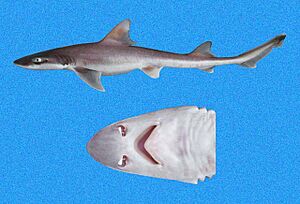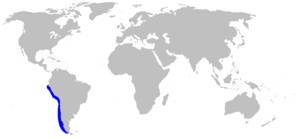Humpback smooth-hound facts for kids
Quick facts for kids Humpback smooth-hound |
|
|---|---|
 |
|
| Conservation status | |
| Scientific classification | |
| Genus: |
Mustelus
|
| Species: |
whitneyi
|
 |
|
The humpback smooth-hound (Mustelus whitneyi) is a type of houndshark. It belongs to the family called Triakidae. You can spot this shark by a slight curve on its back. This curve is just in front of its first dorsal fin, making it look a bit like it has a "humpback."
These sharks live in the warm waters of the southeast Pacific Ocean. They are found off the coasts of Peru and southern Chile. They usually swim near the seafloor, but can be found at depths from 15 to 210 meters (50 to 690 feet). Humpback smooth-hounds are small sharks. They can grow up to 118 centimeters (about 3.9 feet) long.
Humpback smooth-hounds eat fish and small creatures without backbones. They often hunt in areas near the seafloor and in open water. Their favorite food is the Peruvian anchovy. These sharks give birth to live young, which grow inside the mother connected by a special cord. Sadly, their numbers are decreasing because of fishing.
Contents
What Does a Humpback Smooth-Hound Look Like?
The humpback smooth-hound is a small shark. Males usually grow up to 68 cm (27 inches) long. Females are a bit larger, reaching 74-87 cm (29-34 inches). The biggest one ever found was 118 cm (46 inches) long.
This shark has a strong body with a snout that is quite long and wide. Its eyes are large and set far apart. The mouth is also fairly long. Its teeth have a main point, and sometimes smaller points too.
The first dorsal fin is shaped like a triangle. The fins on its sides (pectoral fins) are large, and the fins underneath (pelvic fins) are medium-sized. The tail fin is not very curved in adult sharks. These sharks are plain grey or brownish-grey. They do not have any spots or stripes.
The humpback smooth-hound is built for swimming fast. Its body is almost like a cylinder, which helps it glide through the water. The shape of its first dorsal fin helps it move with less drag. This means it doesn't have to use as much energy to swim. Also, the upper part of its tail fin is much bigger than the lower part. This helps the shark change direction quickly and easily.
Where Do Humpback Smooth-Hounds Live?
You can find the humpback smooth-hound in the southeastern Pacific Ocean. They live off the coasts of Peru and Chile. However, they are much more common in Peru. They usually live in coastal waters, meaning they stay close to the shore.
These sharks can be found at depths between 16 and 211 meters (50 and 690 feet). But they are most often seen between 70 and 100 meters (230 and 330 feet) deep. They live in what is called the marine neritic habitat. This means they are found in the waters over the continental shelves, near the seabed, or close to rocky shores.
Humpback smooth-hounds play an important role in their environment. They move between the benthic (seafloor) and pelagic (open water) areas. This helps to move nutrients and resources between these two different parts of the ocean. They do this by eating and by releasing waste.
Life Cycle and Diet
Humpback smooth-hound sharks are viviparous. This means their babies grow inside the mother's body. The young sharks develop in a special sac connected to the mother. They stay inside for about 10 to 11 months. When they are born, they are usually 22-23 cm (about 9 inches) long. A female humpback smooth-hound typically has about 10 pups in each litter.
These sharks eat many different things. They hunt in both the seafloor and open-water coastal areas. Their diet includes:
They might also eat crustaceans like crabs and mantis shrimps. The Peruvian anchovy is a very important part of their diet. This is a small fish that swims in large groups.
Humpback smooth-hounds are top predators in their ecosystems. This means they have a big impact on other animals. They help control the numbers of their prey through hunting. They also influence how prey animals behave and grow. If there are fewer humpback smooth-hounds, the numbers of squid and other prey might increase. This can cause big changes throughout the ocean ecosystem.
These sharks also help move nutrients between the seafloor and open water. When they eat, poop, or pee, they transport important resources. In seafloor habitats, their hunting can even change the sediment. When they dig for clams or other creatures, they help oxygen get into the sand. This also affects how nitrogen moves through the environment. Their hunting also makes food more available for other species.
Why Are Humpback Smooth-Hounds in Danger?
People fish for humpback smooth-hounds to eat them. This happens mostly in Peru, where these sharks are more common. Fishing is the main reason their population is shrinking. Sharks are caught directly, or sometimes accidentally as "bycatch" in nets meant for other fish.
The way these sharks are caught is not sustainable. This means too many are being removed from the ocean. For example, in Peru, they are often caught in gillnet fisheries. In Ecuador, they are caught as bycatch in trawl fisheries and then thrown away.
The humpback smooth-hound is often caught along with other sharks like the spotted houndshark and the speckled smooth-hound. All three are called "tollo" by local fishers in Peru. The humpback smooth-hound is the main target of this "tollo" fishery. This makes it hard to know exactly how many humpback smooth-hounds are being caught.
Between 1965 and 1989, about 11,000 tons of "tollo" were caught each year in Peru. But after that, the numbers started to drop. In 2001, a rule was made that sharks must be at least 60 cm (24 inches) long to be caught. However, this rule does not protect the adult sharks that are old enough to have babies. This means it doesn't help the population grow.
The humpback smooth-hound is the fourth most caught shark species. It is also the most caught animal that lives on the seafloor. Fishing has caused the population of humpback smooth-hound sharks to drop by more than 80%. Because of this, the International Union for Conservation of Nature (IUCN) has listed the humpback smooth-hound as critically endangered. This means it is at very high risk of becoming extinct.


